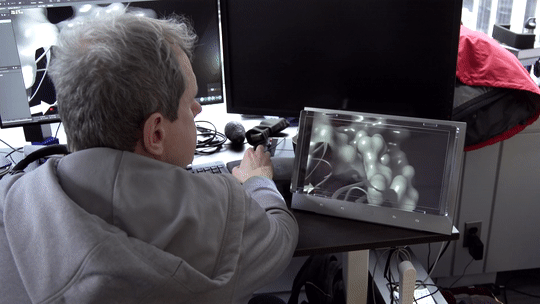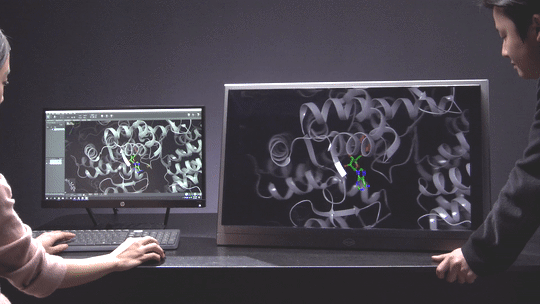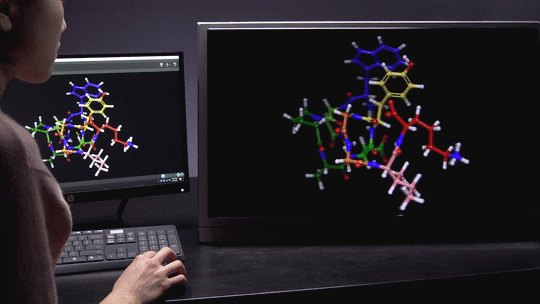Revolutionizing Drug Discovery with the Looking Glass
Schrödinger is an innovative force in developing computational platforms for drug discovery and materials research. Integrating the Looking Glass holographic display into their software platform has enabled collaborative teams of chemists to finally view complex 3D structures together, accelerating the discovery of tomorrow’s medicines and materials.
For thirty years, New York-based software company Schrödinger has been an industry leader in computational chemistry and molecular design. Schrödinger’s physics-based programs assist labs all over the world in improving human health by transforming the way drugs are discovered.
The goal of Schrödinger is to discover cures for diseases, both ones that are very widespread and ones that are currently not being researched because it’s too hard. We’d like to make it much cheaper to perform drug research; in doing so then we can help more and more people by discovering more drugs.
-Pat Lorton, Chief Technology Officer, Schrödinger

Dr. H. Rachel Lagiaokos, a Principal Scientist at Schrödinger, says that viewing in 3D is crucial simply because “life is in 3D.” Schrödinger has been investing in 3D imaging technologies such as Nvidia 3D and the Vision Monitor long before the initial advantages of 3D visualization were widely acknowledged. However, the majority of the tools they’ve used have fallen flat because systems weren’t optimized for group-viewability, users experienced eye-strain after sustained viewing, and the hardware itself wasn’t entirely functional.
The nuances of what capturing something in 3D brings is an extra value that you don’t see when you’re working in 2D. The binding site is full of intricate interactions that can be made. So understanding and appreciating the 3D environment that we work in really brings a lot to [our work] as drug designers.
-Dr. H. Rachel Lagiakos, Principal Scientist, Schrödinger
Integrating the Looking Glass proprietary holographic light field technology with Schrödinger’s state-of-the-art computational platform has fundamentally improved Schrödinger's ability to accelerate the rate of new drug discovery.

The protein is a very complex three-dimensional structure. The active site that we try to target is a complex 3D structure and the ligands that we design, the chemical entities that we design themselves are 3D structures, so understanding and appreciating the 3D environment that we work in really brings a lot to the equation for us as drug designers. And the brilliant thing is everyone brings a different viewpoint based on their background to what they’re looking at.
-Dr. H. Rachel Lagiakos, Principal Scientist, Schrödinger
Schrödinger’s platform is already notably proficient at predicting critical molecular properties with a high degree of accuracy, and since drug discovery is a collaborative effort, enabling teams of dynamic scientists to view complex 3D structures in real-time through the Looking Glass leverages the best that both companies have to offer.

The main advantage of Looking Glass is just how seamless it is and that the collaboration is so much easier. You plug it in, you start Maestro and you have it in 3D [in the Looking Glass]. You don’t have to think about it. You can leave it on all the time. You can be working in 2D and all of a sudden say, ‘hey, I wonder what this is like in 3D’ and just turn your head a little bit. That’s transformational.
-Pat Lorton, Chief Technology Officer, Schrödinger

The simple yet profound value of the Looking Glass as a holographic second monitor is that users can individually and collectively interact with 3D holographic content without any head-mounted displays or additional hardware. Additionally, because the Looking Glass doesn’t cause headaches or eye-strain like many single-viewer systems, professionals can now maneuver 3D environments as much as their work requires them to.
By enabling all of our designers with [the Looking Glass] technology, not just the ones who are really committed to it, we hope it will help improve insights and accelerate the discovery of better drug candidates that may one day help cure diseases; and these candidates may possess functions and properties that are better understood by examining the detailed 3D structures and interactions with the protein target. With proper skill and the right hard work, you’re able to see breakthroughs in 3D.
-Pat Lorton, Chief Technology Officer, Schrödinger
With the Looking Glass holographic display on desks throughout Schrödinger’s offices, scientists are reaping the benefits of having the third-dimension at their fingertips. Schrödinger has always kept one eye on the future. This implementation of the Looking Glass serves as one small step for their company, and one giant leap towards the medicines of tomorrow.
To find out how Looking Glass technology can modernize your workflow, send us a message at sales@lookingglassfactory.com.
